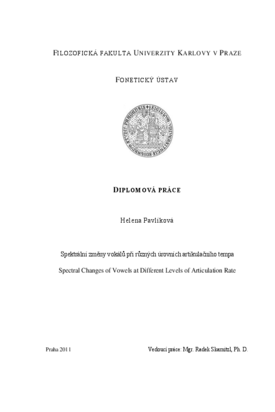Spektrální změny vokálů při různých úrovních artikulačního tempa
Spectral Changes of Vowels at Different Levels of Articulation Rate
diplomová práce (OBHÁJENO)

Zobrazit/
Trvalý odkaz
http://hdl.handle.net/20.500.11956/48501Identifikátory
SIS: 97582
Kolekce
- Kvalifikační práce [22841]
Autor
Vedoucí práce
Oponent práce
Studenovský, David
Fakulta / součást
Filozofická fakulta
Obor
Český jazyk a literatura - Fonetika
Katedra / ústav / klinika
Fonetický ústav
Datum obhajoby
14. 9. 2011
Nakladatel
Univerzita Karlova, Filozofická fakultaJazyk
Čeština
Známka
Výborně
V této práci se zabýváme změnami krátkých vokálů v češtině v souvislosti se změnou úrovně artikulačního tempa. Použili jsme čtený text ve třech úrovních artikulačního tempa od 13 mluvčích. Měřili jsme trvání vokálů a frekvence F1-F3, naměřené frekvence v hertzích jsme normalizovali pomocí Lobanovovy transformační procedury. Data jsme analyzovali pomocí statistických t-testů. Se zvýšením artikulačního tempa došlo u všech vokálů ke zkrácení trvání. Dále došlo se zvýšením artikulačního tempa k centralizaci krátkých vokálů v rámci vokalického prostoru - nejvýraznější změny jsme zaznamenali u krajních vokálů vokalického systému /i/, /a/, /u/. Nejmenší byly změny u /e/. Ovlivněny byly především hodnoty F1 a F2, u třetího formantu jsme pravidelný posun nezaznamenali. Centralizovaly se i vokály silně ovlivněné předcházejícími konsonanty, nelišilo se chování přízvučných a nepřízvučných vokálů. Výraznější byly posuny mezi kategoriemi danými trváním vokálů než úrovní artikulačního tempa. Výraznější byla centralizace u mluvčích, kteří mezi jednotlivými úrovněmi tempa dosáhli vyšších rozdílů. Klíčová slova: artikulační tempo, frekvence vokalických formantů, trvání, redukce, centralizace, koartikulace
The thesis deals with short vowel changes in different level of articulation rate in Czech. Read texts in three levels of articulation rate from 13 people were used. The duration of vowels and the frequencies of F1-F3 were measured, the frequencies in Hertz were normalized using Lobanov's normalizing method. The data were analyzed with Student's t-test. The duration of the vowels was shortened with the higher level of articulation rate. The vowels were systematically centralized and the vowel space shrank with the higher level of articulation rate. The centralization was strongest at the edges of the vowel space - /i/, /a/, /u/. The least changes were found in /e/. Particularly the frequencies of F1 and F2 were influenced, no systematic changes were found in F3. Even the vowels strongly influenced with preceding consonant were centralized, and there was no difference between stressed and unstressed vowels. The centralization was stronger when the vowels were chosen with regard to their duration (compared to the level of articulation rate). The centralization was stronger in the speakers with higher differences in articulation rate levels. Keywords: articulation rate, vowel formant frequencies, duration, reduction, centralization, coarticulation
